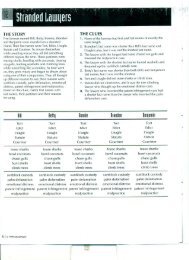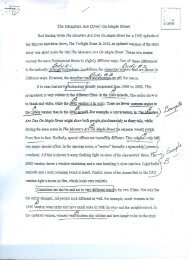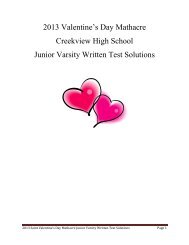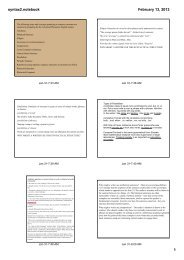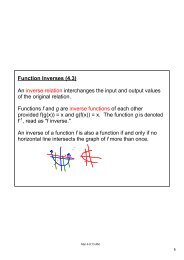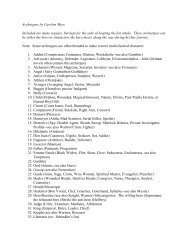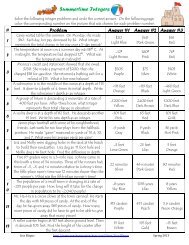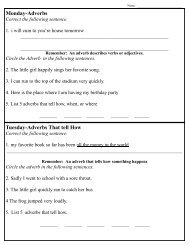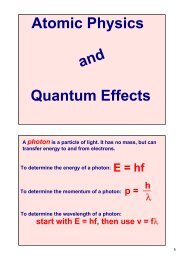Rosencrantz and Guildenstern Are Dead - Cherokee County Schools
Rosencrantz and Guildenstern Are Dead - Cherokee County Schools
Rosencrantz and Guildenstern Are Dead - Cherokee County Schools
Create successful ePaper yourself
Turn your PDF publications into a flip-book with our unique Google optimized e-Paper software.
Stoppard after the death of the boy' s father. Educated from the age of five (in English) in India <strong>and</strong> from the<br />
age of nine in Engl<strong>and</strong>, Stoppard left school at seventeen to become a journalist before deciding in 1960, at<br />
the age of twenty-three, to become a full-time writer.<br />
Before becoming an "overnight" sensation with <strong>Rosencrantz</strong> <strong>and</strong> <strong>Guildenstern</strong> <strong>Are</strong> <strong>Dead</strong>, Stoppard worked as<br />
a freelance writer <strong>and</strong> drama critic in London, writing stage plays, television plays, radio plays, short stories,<br />
<strong>and</strong> his only novel, Lord Malquist <strong>and</strong> Mr. Moon. The turning point in his writing career came in 1963 when<br />
his agent, Kenneth Ewing, wondered in casual conversation who the King of Engl<strong>and</strong> might have been during<br />
the time of Shakespeare's Hamlet. The question prompted Stoppard to write a one-act verse burlesque entitled<br />
<strong>Rosencrantz</strong> <strong>and</strong> <strong>Guildenstern</strong> Meet King Lear, <strong>and</strong> when Stoppard participated in a writing colloquium for<br />
young playwrights in Berlin in 1964 he submitted a version of this text.<br />
Stoppard eventually discarded from this play most of the verse <strong>and</strong> the references to King Lear, gradually<br />
focusing on events in Hamlet's Elsinore. In August of 1966, Stoppard helped direct the first production of the<br />
play in Edinburgh. Though the play was "done in a church hall on a flat floor" with "no scenery" <strong>and</strong> "student<br />
actors," influential London theatre critic Ronald Bryden perceived the play's potential <strong>and</strong> wrote that<br />
Stoppard's play was "the best thing at Edinburgh so far'' <strong>and</strong> that "it's the most brilliant debut by a young<br />
playwright since John Arden." Bryden's review convinced the National Theatre in London to produce the play<br />
<strong>and</strong> Stoppard soon vaulted into international prominence.<br />
Since his phenomenal success with <strong>Rosencrantz</strong> <strong>and</strong> <strong>Guildenstern</strong> <strong>Are</strong> <strong>Dead</strong> Stoppard has produced a large<br />
body of work that critics continue to find intelligent, erudite, witty, <strong>and</strong> filled with verbal pyrotechnics. A<br />
number of early critics questioned whether this dazzling surface was supported by genuine profundity <strong>and</strong><br />
many early critics found Stoppard's plays coldly analytical rather than emotionally powerful. But The Real<br />
Thing in 1982 <strong>and</strong> Arcadia in 1993 seemed to deliver the kind of pathos his highly intellectual "philosophical<br />
farces" might have been lacking. Though not unanimously acclaimed by critics today, Stoppard is undeniably<br />
a major figure in contemporary drama. He has also written a number of adaptations of plays in foreign<br />
languages <strong>and</strong> several screen plays, including a feature film version of <strong>Rosencrantz</strong> <strong>and</strong> <strong>Guildenstern</strong> <strong>Are</strong><br />
<strong>Dead</strong> in 1990.<br />
Themes<br />
Human Condition<br />
Stoppard's <strong>Rosencrantz</strong> <strong>and</strong> <strong>Guildenstern</strong> <strong>Are</strong> <strong>Dead</strong> blends two stories—Shakespeare's Hamlet <strong>and</strong> Stoppard's<br />
own version of how the two courtiers might have felt <strong>and</strong> behaved after they were summoned by King<br />
Claudius to spy on their schoolmate, Hamlet.<br />
When Stoppard decided to write about <strong>Rosencrantz</strong> <strong>and</strong> <strong>Guildenstern</strong> he was free to give them personalities of<br />
his own because Shakespeare had hardly given them any personalities at all. He was also free to let them<br />
speak in a more colloquial language <strong>and</strong> to elaborate on aspects of their lives that Shakespeare did not specify,<br />
such as what they might have done with Hamlet on the ship to Engl<strong>and</strong>. But once Stoppard chose to blend his<br />
story with Shakespeare's, <strong>Rosencrantz</strong> <strong>and</strong> <strong>Guildenstern</strong> were fated to die at the end of Stoppard's story<br />
because they die at the end of Shakespeare's. Stoppard uses this literary fatalism as a metaphor for the fate that<br />
awaits all human beings—the inevitability of death.<br />
The play begins with Stoppard's story, as two very un-Shakespearean courtiers flip coins as they pause on the<br />
road to Elsinore. The extraordinary suspension of the laws of probability that permits over 100 coins to l<strong>and</strong><br />
"heads" before one l<strong>and</strong>s "tails" indicates that there is something special about this day. And when a coin<br />
finally l<strong>and</strong>s "tails" <strong>Rosencrantz</strong> <strong>and</strong> <strong>Guildenstern</strong> are immediately swept out of Stoppard's story <strong>and</strong> back into<br />
Shakespeare's, from which they originally came. Once they are placed in Shakespeare's story, their fate is<br />
Biography 4





